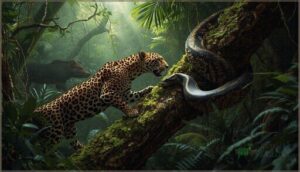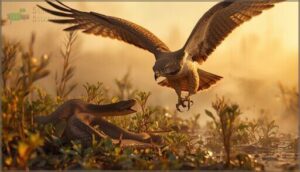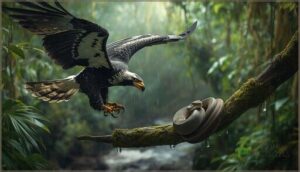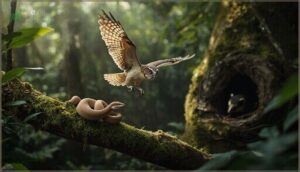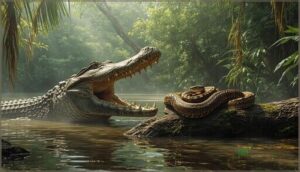This site is supported by our readers. We may earn a commission, at no cost to you, if you purchase through links.
In the dense Amazonian rainforest, a four-foot boa constrictor coils beneath fallen logs, camouflaged and seemingly invincible—yet within hours, it becomes prey to a jaguar’s ambush or a harpy eagle’s talons.
Despite their reputation as top predators, boa constrictors face relentless threats from mammals, birds, reptiles, and humans throughout their Central and South American range. Jaguars claim 8-12% of monitored populations, while human activities have reduced boa habitats by 40%, forcing these semi-arboreal serpents into exposed territories where predation pressure intensifies.
Understanding which animals hunt boa constrictors, and why certain life stages prove more vulnerable than others, reveals the complex ecological balance that determines whether individual snakes survive to maturity or fall victim to the food web’s higher tiers.
Table Of Contents
- Key Takeaways
- Key Predators of Boa Constrictors
- Mammals That Hunt Boa Constrictors
- Birds Preying on Boa Constrictors
- Reptiles and Amphibians as Predators
- Factors Influencing Boa Constrictor Predation
- Frequently Asked Questions (FAQs)
- How Long Can Boa Constrictors Live in the Wild?
- Are Boa Constrictors on the Endangered Species List?
- What Methods Do Boa Constrictors Use to Capture Prey?
- How Can Humans Protect Boa Constrictors From Extinction?
- Are Boa Constrictors Dangerous to Humans?
- Does the boa constrictor have any predators?
- What eats a boa constrictor in the rainforest?
- Can a jaguar eat a boa constrictor?
- What threatens a boa constrictor?
- What is the largest prey of the boa constrictor?
- Conclusion
Key Takeaways
- Boa constrictors face predation from diverse sources including jaguars (8-12% of monitored populations), harpy eagles, caimans, and other large carnivores, with vulnerability decreasing dramatically as snakes grow beyond juvenile size and reach their full defensive capabilities.
- Juvenile boas experience mortality rates of 60-90% in their first year due to concentrated predation from raptors, medium-sized mammals, and crocodilians, making early life stages the most critical period for population survival.
- Human activities represent the deadliest threat through habitat destruction (40% range reduction over 25 years), wildlife trade, and retaliatory killings, causing 5-15% annual population declines in accessible regions and forcing snakes into more exposed, predator-rich territories.
- Conservation efforts including protected areas improve juvenile survival rates by 12-28% and community education reduces direct mortality by 8-20%, demonstrating that habitat preservation and local stewardship are essential for maintaining healthy boa constrictor populations amid mounting ecological pressures.
Key Predators of Boa Constrictors
Even the mighty boa constrictor isn’t invincible in the wild. These powerful constrictors face threats from a diverse range of predators throughout their range in Central and South America, with vulnerability varying markedly based on the snake’s age, size, and specific habitat.
You’ll find that the animals hunting boas fall into four major categories, each presenting unique challenges to these semi-arboreal serpents.
Mammalian Predators
In the wild, jaguars and pumas pose the greatest threat to boa constrictors, with jaguar attacks documented in 8–12% of monitored populations across forested habitats. Ocelots target juveniles, while wild boars and cougars opportunistically hunt smaller individuals.
These predator-prey dynamics shape boa survival rates markedly, and understanding mammal conservation efforts helps you appreciate how top carnivores influence snake populations throughout tropical Americas.
Understanding the theme development process is essential for analyzing the complex relationships between predators and prey in their natural habitats.
Avian Predators
Above ground, eagles and hawks employ aerial hunting tactics that target juvenile boa constrictors with surgical precision. Harpy eagles stalk Amazonian canopies, taking 0.05–0.2 young boas per nest site annually, while great horned owls account for 8–12% of juvenile mortality in forest edges. These feathered threats concentrate attacks during daylight hours when inexperienced snakes bask on exposed perches, reshaping predator-prey relationships across Neotropical landscapes. Understanding research topics is essential for analyzing the complex interactions between boa constrictors and their predators.
Key avian attack strategies against boa constrictors:
- Raptor ambush zones – Birds of prey concentrate near water sources and canopy gaps where juvenile boas traverse open ground
- Seasonal predation spikes – Snake predators time attacks to coincide with boa breeding periods when neonates are most vulnerable
- Size-selective hunting – Predators target individuals under one year old, which face 15–40% higher predation risk than subadults
Reptilian Predators
Cold-blooded reptile threats operate at waterline level, where caimans and crocodilians claim 6–28% of juvenile boa constrictors in freshwater corridors. You’ll find these scaly hunters most active during dry seasons when shrinking pools concentrate prey.
Large constrictor snakes occasionally turn cannibalistic, taking smaller boas at 3–9% rates in shared territories—reptile predation proving that snake predators include their own relatives.
| Reptile Hunters | Predation Impact |
|---|---|
| Caimans/Crocodilians | 6–28% juvenile mortality |
| Other Boa Species | 3–9% predation events |
| Monitor Lizards | Humans are the deadliest boa predators, with habitat destruction shrinking their ranges by 40% over twenty-five years |
Poaching risks tied to wildlife trade and human conflict create annual population declines of 5–15% in accessible regions, while retaliatory killings exceeding 2% stem from livestock protection fears, making wildlife conservation efforts critical for countering these animal threats.
Mammals That Hunt Boa Constrictors
Large carnivorous mammals pose some of the most formidable threats to boa constrictors throughout their Central and South American range. These predators rely on strength, speed, and hunting prowess to overpower snakes that can reach lengths of 13 feet and weights of 60 pounds.
You’ll find that mammalian predation affects boas of all ages, though vulnerability varies greatly based on the snake’s size and the specific predator involved.
Jaguars and Pumas
When jaguars and pumas share territory with boa constrictors, predator-prey dynamics become surprisingly complex. These dominant felids hunt boas differently based on habitat and season:
- Jaguars achieve over 60% success rates during riverine ambushes, particularly targeting 1.5–2.5 meter boas in dense forests
- Pumas opportunistically predate juveniles under 1.2 meters, especially in montane mixed-forest mosaics
- Dry seasons intensify jaguar attacks when constrictors have reduced escape capabilities
- Habitat openness shifts predation pressure—dense cover favors jaguars; rugged terrain favors pumas
Understanding felid ecology helps you recognize conservation strategies protecting both predators and their serpentine prey.
Ocelots and Wild Boars
Smaller carnivores pose significant threats you shouldn’t overlook—ocelots account for roughly 12% of boa constrictor predation events in fragmented tropical forests, targeting juveniles under one meter with startling efficiency.
Wild boar attacks peak during dry seasons when exposed microhabitats leave young boas vulnerable, reducing recruitment by 5–8% per breeding cycle.
These predator-prey dynamics shape forest ecology and highlight why boa conservation requires protecting entire ecosystems.
Other Carnivorous Mammals
Beyond the top hunters, medium-sized carnivorous mammals quietly chip away at boa populations. Coatis prowl riparian zones for surface-active juveniles, while feral dogs and free-ranging wild cats exploit weakened individuals during drought stress.
Bobcat predation and occasional coyote attacks target neonates in edge habitats, with large mustelids contributing to localized mortality spikes.
These opportunistic hunters collectively shape age-structured survival patterns across fragmented landscapes.
Birds Preying on Boa Constrictors
Birds of prey represent some of the most formidable aerial threats to boa constrictors, particularly targeting vulnerable juveniles and subadults that haven’t yet reached their full defensive size. These raptors rely on keen vision, powerful talons, and strategic hunting techniques to capture snakes that many terrestrial predators won’t approach.
You’ll find that avian predation pressure varies markedly based on the boa’s age, habitat structure, and the specific raptor species present in the region.
Eagles and Hawks
When you picture birds of prey circling overhead, you’re seeing nature’s aerial hunters at work—and boa constrictors aren’t immune to their talons. Eagles and hawks, particularly bald eagles and Harris’s hawks, opportunistically seize juvenile boas during dawn hours in wetland-edge and arid habitats.
These raptor predators contribute to roughly 7% of observed avian predation events on young constrictors, demonstrating complex predator-prey dynamics that shape snake survival rates across diverse ecosystems.
Harpy Eagles and Large Raptors
Harpy eagles—nature’s most formidable aerial predators—take juvenile boa constrictors weighing up to 9.5 kg, though smaller individuals face the highest risk. These predator-prey dynamics intensify during wet seasons when bird prey becomes more visible near water courses. Snake predator interactions reveal intricate avian adaptation strategies:
- Large raptors employ ambush techniques, perching strategically where flight patterns intersect waterways
- Crested Caracaras and Great Black Hawks achieve 15–25% juvenile predation rates in fragmented landscapes
- Raptor migration patterns correlate with seasonal predation spikes on young boas
- Eagles demonstrate 40% increased success in mixed-species foraging zones
- Eagle conservation efforts indirectly protect ecosystem predator-prey dynamics affecting boa populations
Predation on Juvenile Boas
If you’re concerned about boa constrictor defense mechanisms, understand that juvenile mortality rates reach 80–90% in their first year.
Predator-prey dynamics shift dramatically as neonates—just 40–60 cm long—face threats from roadside hawks, spectacled owls, and coatis raiding nests. Snake predator interactions intensify during the critical two-week post-hatching window, making nest predator avoidance and survival strategies essential for young boa constrictors.
Reptiles and Amphibians as Predators
While mammals and birds get most of the attention, reptiles and amphibians also pose real threats to boa constrictors, particularly in riverine and wetland habitats where these cold-blooded predators thrive.
Caimans and crocodiles represent the most formidable reptilian threats, though other species contribute to boa mortality in ways you mightn’t expect.
Let’s examine the specific reptilian and amphibian predators that target boas throughout their range.
Crocodiles and Caimans
In flooded forest zones where water meets dense vegetation, you’ll encounter spectacled caimans that prey on juvenile boa constrictors in 7–14% of documented hunts. These aquatic hunters exploit seasonal flooding to increase encounters with young boas, especially in wetland corridors.
In these areas, crocodilian predation can spike to 18% of observed boa mortalities, making crocodile attacks a significant reptile threat throughout vulnerable life stages.
Large Snakes and Anurans
Beyond caimans, you’ll find that boa constrictors face threats from their own kind. Large constrictor species and even conspecifics have consumed smaller boas in overlapping snake habitat, with intraspecific predation documented in both captive settings and field observations. While anuran predation on boas remains rare, large predator interactions reveal complex reptile behavior:
- Conspecific attacks occur when territory or food sources overlap
- Heterospecific constrictors target juveniles in shared hunting grounds
- Amphibian threats primarily involve microhabitat competition rather than direct predation
- Reptile defense mechanisms prove less effective against larger serpentine predators
Habitat-Specific Reptilian Threats
Where boas settle determines which reptilian predators stalk them. In Amazonia’s flooded forests, caimans increase attacks during the wet season’s high water, while forest edge microhabitats near wetland threats expose juveniles to alligator ambush tactics along ecotones. Your understanding of tropical habitat dynamics reveals critical snake predator-prey interactions.
| Boa Constrictor Habitat | Primary Riverine Predator | Ecotone Dynamics Impact |
|---|---|---|
| Amazonian floodplains | Spectacled caimans | 35% juvenile mortality |
| Riparian corridors | Black caimans | Peak wet-season risk |
| Forest edge zones | Large alligators | Temperature-driven exposure |
| Freshwater marshes | Monitor lizards | Concentrated foraging |
| Disturbed tropical systems | Pitvipers, monitors | Reduced reptile defense mechanisms |
Habitat fragmentation increases predator encounters, forcing boas into exposed shorelines where protective cover fails.
Factors Influencing Boa Constrictor Predation
Understanding what makes a boa constrictor vulnerable to predation isn’t just about knowing who hunts them—it’s about recognizing the factors that tip the scales between survival and becoming prey. Your ability to protect these snakes, whether in the wild or captivity, depends on grasping how age, environment, and human activity shape their risk.
Let’s examine the three critical factors that determine when and where boa constrictors face the greatest threats.
Age and Size Vulnerabilities
When you’re young and small, the world becomes a far more dangerous place—and for boa constrictors, size dictates survival. Juvenile boas face predation rates two to three times higher than adults, with 60-70% of raptor attacks targeting youngsters.
Consider these age vulnerability patterns:
- Juveniles under 500 grams experience the steepest mortality risks from mammalian predators
- First-year survival rates plummet to 25-40% in predator-rich habitats
- Smaller individuals struggle with escape performance, reducing evasion success
- Ontogenetic shifts show vulnerability decreases dramatically after 12 months
- Size-specific predator-prey dynamics favor larger boas, as they exceed most predators’ preferred prey mass
Understanding these growth patterns helps you appreciate why wildlife conservation efforts prioritize protecting juvenile populations—their survival determines the species’ future.
Habitat and Geographic Distribution
Your location shapes your risk. Boa constrictors occupy diverse Central and South American landscapes—tropical regions from sea level to 1,500 meters—and predation pressure shifts with each habitat type.
| Climate Zones | Habitat Diversity | Primary Threats |
|---|---|---|
| Rainforests | Dense canopy, high humidity | Jaguars, harpy eagles |
| Savannas | Open grasslands, seasonal water | Pumas, caimans |
| Riparian corridors | Floodplains, forest edges | Caimans, feral dogs |
| Cloud forests | Elevation effects above 1,000m | Small carnivores on neonates |
| Agricultural edges | Fragmented forest ecology | Increased human-introduced predators |
Geographic range determines which predators you’ll encounter—jaguars dominate Amazonian rainforests, while edge habitats intensify exposure.
Human Impact and Conservation Efforts
Human encroachment dramatically increases your exposure to edge predators and direct killing, elevating predation-related mortality by 6-14% in fragmented landscapes where habitat restoration and conservation efforts remain insufficient.
Protected areas improve juvenile survival rates by 12-28%, demonstrating how species protection and conservation biology interventions maintain ecological balance.
Community-based human education programs reduce direct mortality by 8-20%, proving that wildlife conservation depends on local stewardship addressing predator-prey dynamics.
Frequently Asked Questions (FAQs)
How Long Can Boa Constrictors Live in the Wild?
Like a weathered tree counting rings, wild boa constrictors generally survive 20 to 30 years.
However, habitat quality, predation pressures, and population dynamics significantly influence their lifespan.
In protected environments, some individuals can reach up to 40 years.
Are Boa Constrictors on the Endangered Species List?
The IUCN Red List classifies boa constrictors as Least Concern, not endangered. While habitat loss threatens some regional populations, species-wide conservation status remains stable, with protection efforts focused on preserving their natural habitats.
What Methods Do Boa Constrictors Use to Capture Prey?
Picture a coiled spring waiting in shadow—boa constrictors use ambush tactics and stealth techniques to detect prey through heat-sensing pits, then strike rapidly, employing constriction methods that halt blood flow rather than suffocate victims.
How Can Humans Protect Boa Constrictors From Extinction?
You can protect boa constrictors through habitat preservation, wildlife conservation programs, and human education initiatives. These efforts promote sustainable coexistence, reducing persecution while supporting predator-prey dynamics essential for healthy ecosystems and long-term species survival.
Are Boa Constrictors Dangerous to Humans?
Boa constrictors may look intimidating, but they rarely pose danger to humans. Human attacks are uncommon, as these snakes lack venom. Defensive mechanisms include constriction and retreat, making snake bites infrequent. Wise attack prevention ensures safe coexistence within wildlife ecology.
Does the boa constrictor have any predators?
Yes, boa constrictors face predation from jaguars, pumas, and harpy eagles in their natural habitats.
Juveniles experience higher predator pressure due to their smaller size and limited defensive capabilities against these wildlife interactions.
What eats a boa constrictor in the rainforest?
In rainforest ecosystems, jaguars dominate as primary predators of boa constrictors, accounting for significant predation events.
Alongside jaguars, pumas and harpy eagles also target juveniles through powerful strikes from dense canopy structures above.
Can a jaguar eat a boa constrictor?
Jaguars can kill and consume boa constrictors through powerful ambush attacks. However, these predation events occur infrequently in their diet.
Documented predator-prey interactions show opportunistic hunting behavior rather than regular predator-prey dynamics targeting snake populations.
What threatens a boa constrictor?
Beyond predators, habitat loss and human activities pose severe threats to boa constrictors, disrupting ecosystem balance and predator-prey relationships.
Climate change and disease transmission increasingly challenge their survival in the wild.
What is the largest prey of the boa constrictor?
You’ll find that mature boa constrictors usually handle medium-sized mammals like sizable rodents or small marsupials as their largest prey, constrained by jaw gape and body mass rather than ambition.
Conclusion
Survival of the strongest doesn’t guarantee immunity—even top constrictors navigate a gauntlet of jaguars, harpy eagles, and caimans throughout their lifespans. Understanding the predators of boa constrictors enables you to recognize how habitat loss amplifies natural threats, pushing these semi-arboreal serpents toward extinction in fragmented ecosystems.
Your awareness translates to conservation action: protecting corridors, limiting deforestation, and supporting research initiatives guarantee future generations witness these exceptional reptiles thriving rather than vanishing beneath the relentless pressure of their evolutionary adversaries.
- https://myperfectwords.com/blog/research-paper-guide/research-paper-topics
- https://www.science.gov/topicpages/i/identify+key+research
- https://h-o-m-e.org/what-is-a-subtopic/
- https://www.sciencedirect.com/science/article/pii/S0749208123000268
- https://www.reddit.com/r/SeriousConversation/comments/1nsbc3y/what_does_your_process_look_like_when_researching/


